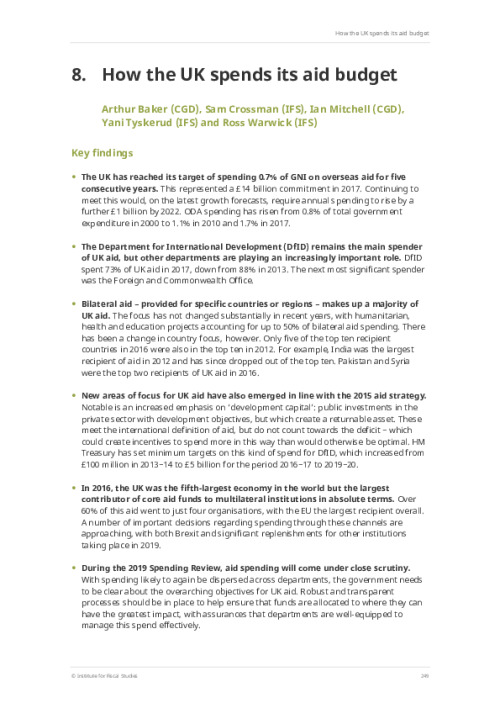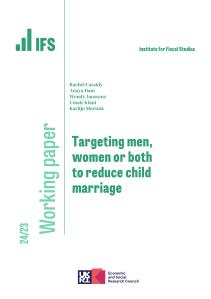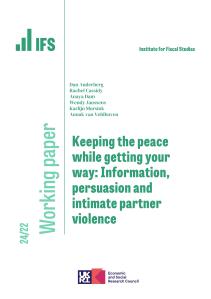The UK is committed by law to spending 0.7% of gross national income on overseas aid every year. This fiscal commitment is notable given the significant public spending pressures across government. In this context, the government has overseen some important changes to how its aid is allocated in recent years. These include the pursuit of new strategic objectives, a greater emphasis on a cross-government approach, and an explicit focus on the role aid can play in serving the UK’s national interest.
This chapter does not seek to offer new evidence on the effectiveness of UK aid or to provide recommendations on how – or how much – aid should be spent. Instead, we provide a descriptive analysis of aggregate UK aid spending and its composition. We draw out trends in how this composition has changed and highlight where this appears to be driven by recent updates to the government’s overarching strategy, outlining potential challenges and areas of uncertainty for the future of UK aid along the way.
Key findings
- The UK has reached its target of spending 0.7% of GNI on overseas aid for five consecutive years. This represented a £14 billion commitment in 2017. Continuing to meet this would, on the latest growth forecasts, require annual spending to rise by a further £1 billion by 2022. ODA spending has risen from 0.8% of total government expenditure in 2000 to 1.1% in 2010 and 1.7% in 2017.
- The Department for International Development (DfID) remains the main spender of UK aid, but other departments are playing an increasingly important role. DfID spent 73% of UK aid in 2017, down from 88% in 2013. The next most significant spender was the Foreign and Commonwealth Office.
- Bilateral aid – provided for specific countries or regions – makes up a majority of UK aid. The focus has not changed substantially in recent years, with humanitarian, health and education projects accounting for up to 50% of bilateral aid spending. There has been a change in country focus, however. Only five of the top ten recipient countries in 2016 were also in the top ten in 2012. For example, India was the largest recipient of aid in 2012 and has since dropped out of the top ten. Pakistan and Syria were the top two recipients of UK aid in 2016.
- New areas of focus for UK aid have also emerged in line with the 2015 aid strategy. Notable is an increased emphasis on ‘development capital’: public investments in the private sector with development objectives, but which create a returnable asset. These meet the international definition of aid, but do not count towards the deficit – which could create incentives to spend more in this way than would otherwise be optimal. HM Treasury has set minimum targets on this kind of spend for DfID, which increased from £100million in 2013–14 to £5billion for the period 2016–17 to 2019–20.
- In 2016, the UK was the fifth-largest economy in the world but the largest contributor of core aid funds to multilateral institutions in absolute terms. Over 60% of this aid went to just four organisations, with the EU the largest recipient overall. A number of important decisions regarding spending through these channels are approaching, with both Brexit and significant replenishments for other institutions taking place in 2019.
- During the 2019 Spending Review, aid spending will come under close scrutiny. With spending likely to again be dispersed across departments, the government needs to be clear about the overarching objectives for UK aid. Robust and transparent processes should be in place to help ensure that funds are allocated to where they can have the greatest impact, with assurances that departments are well-equipped to manage this spend effectively.
This is a pre-released chapter from the IFS Green Budget that will be published on October 16th. The Green Budget is being produced in association with the ICAEW and Citi and is funded by the Nuffield Foundation.











